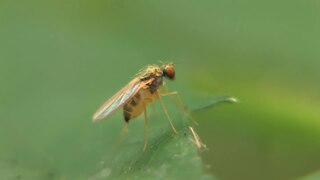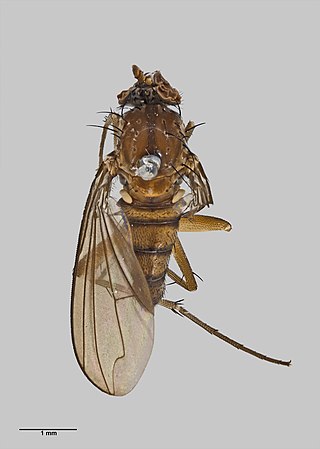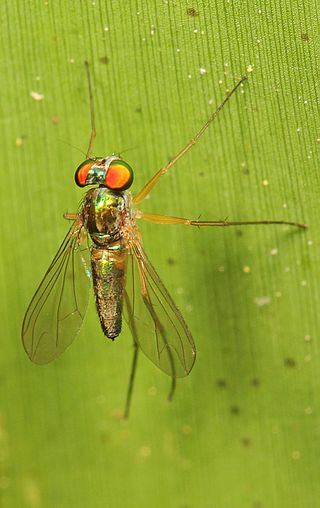Abbemyia is a genus of flies in the family Dolichopodidae, known from Australia and New Caledonia. It is named after the French entomologist Abbé Octave Parent, who studied the family Dolichopodidae.
Chaetogonopteron is a genus of flies in the family Dolichopodidae.

Chrysotimus is a genus of longlegged flies in the family Dolichopodidae. It is cosmopolitan in distribution, but it is probably paraphyletic with respect to several genera of limited distribution.
Corindia is a genus of flies in the family Dolichopodidae. It is known from the Afrotropical and Australasian realms, and is closely related to the genus Thrypticus. In Australia, adults of the genus are often found on smooth-barked eucalypt trees, and display a stance similar to that of Medetera. The genus is named after Corindi, a geographical place name of aboriginal origin on the New South Wales northern coast.
Helixocerus is a genus of flies in the family Dolichopodidae. It is known from New Caledonia, American Samoa and Western Samoa.

Medetera is a large genus of flies in the family Dolichopodidae. It includes about 350 species worldwide. The adults are commonly found resting on vertical surfaces such as tree trunks. The larvae are predators of bark beetle larvae.

Paraclius is a genus of flies in the family Dolichopodidae.
Pilbara octava is a species of fly in the family Dolichopodidae from Australia, and the only member of the genus Pilbara. The genus is named after the Pilbara region of Western Australia, where P. octava was found. In particular, the only known location of P. octava is at Millstream, Fortescue River.
Pseudoparentia is a genus of flies in the family Dolichopodidae. It is known from Australia.

Sciapus is a genus of long-legged flies in the family Dolichopodidae. There are about 82 described species in Sciapus.

Thinophilus is a genus of flies in the family Dolichopodidae. It includes about 146 described species distributed worldwide. Most species of the genus are found in coastal habitats, while a few species are found in freshwater habitats.

Sciapodinae is a subfamily of flies in the family Dolichopodidae.

Diaphorinae is a subfamily of flies in the family Dolichopodidae.
Cryptophleps is a genus of flies in the family Dolichopodidae.

Medeterinae is a subfamily of flies in the family Dolichopodidae.

Peloropeodinae is a subfamily of flies in the family Dolichopodidae. In some classifications, the genera of the subfamily are included in Sympycninae. According to Germann et al. (2011), the subfamily is polyphyletic.
Demetera is a genus of flies in the family Dolichopodidae. It contains eight species formerly included in Medetera in the M. melanesiana species group. The species are found in the Afrotropical, Oriental and Australasian regions. According to Naglis and Bickel (2012), it was unwarranted to establish a separate genus for this group of species.

Chrysosomatini is a tribe of flies in the family Dolichopodidae.









